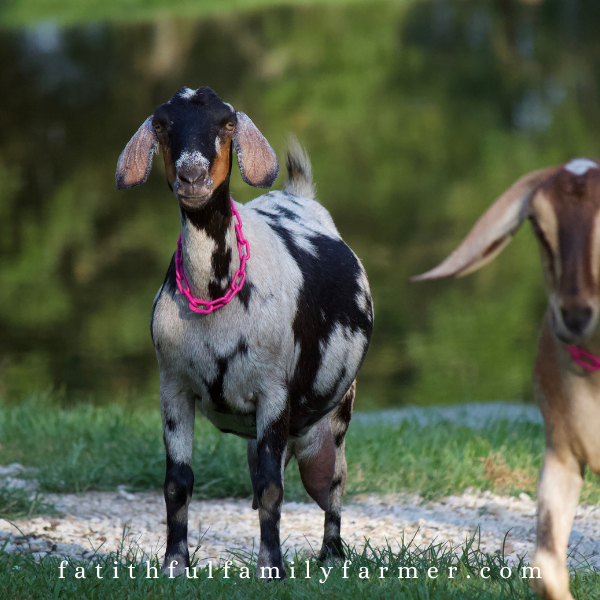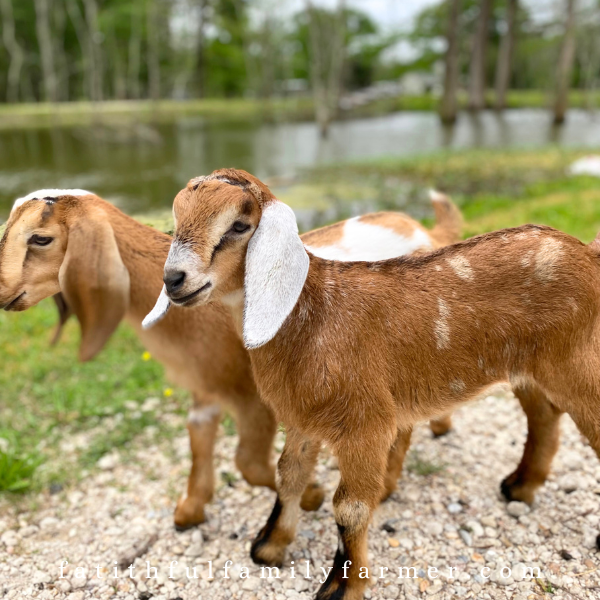Goat Labor Signs and Birth Care (Free Birth Prep Checklist)
This is the most exciting time of the year, kidding season. If you are new to raising goats, it’s incredibly important to know what to expect during labor. You’ll also want to know how to take care of your pregnant doe after she delivers her adorable new babies. A good thing to learn is a goat’s gestation period as well, you can check out how long goats are pregnant for in this post. Also, Don’t forget your free birth prep checklist!

This is not medical advice, please consult with your vet or goat mentor for serious complications or medical issues.
Whether you are a newbie raising goats or you’ve been at it a few years, it’s always good to be prepared for kidding season. If you aren’t new, you know goats like to throw you wild & new surprises. They don’t always follow rules like they should haha! We’ve been raising goats for 3 years now and I learn something new from each kidding we experience.
This last kidding season in particular was pretty intense. We had a doe who simply would not progress and her cervix did not dilate so we had to manually dilate her and delivery the baby goat ourselves. Naturally it was on a Sunday and we could not get a vet to come out, it was so traumatic for the dam, the baby, and us to be honest. The wild thing is the baby was not in the wrong position, his front hooves were present, he was just giant. Of course, it was my favorite doe and I hate seeing her struggle. Thankfully we were prepared and had plenty of goat mentors to call during that stressful time.
Staying Prepared is Key
My hope is that you won’t have to experience what we did without any of the right tools. Being present during the labor is just as important as being prepared. It’s important to watch the doe so you can notice any unusual signs or symptoms she may experience. Thankfully, we were there all night the night before our doe kidded. We would have never known something was wrong. She labored all night and all morning with no signs of pushing. We knew something was wrong. I was thankful my husband stayed up all night with her watching. Truly a blessing indeed, she may not be here today if we wouldn’t have kept such a close eye on her. Definitely not a normal delivery but thankfully the new kid and momma were healthy afterwards.

What Are The Signs Of Goat Labor?
While each goat is VERY different (trust me, they aren’t all the same) , these are some general guidelines to go by. If you know your goat well, it is pretty easy to tell when they are really in labor.
Separating themselves from the rest of the heard
This is a pretty obvious sign that your goat is either in labor or labor is very near. It’s usually an early stage of labor. This is also a pretty consistent sign, all of my goats I’ve ever owned will separate themselves from the heard. But who’s to say there’s a goat out there that doesn’t like to go by the books haha, we all know at least one This is a good time to put them in a kidding stall so they can focus and feel comfortable.
If it’s early labor, you may be able to leave them out with the others if you can go out and check on them throughout the day. If it’s a night time, I always separate if I suspect newborn kids are coming within the next 48 hours.
Calling out or being louder than usual
Not all does will do this. I had a first time mom who went into labor and would not keep quiet. It was so strange because aside from labor she never made a peep. I knew that was a definite sign babies were coming soon. As a first freshener, I was appreciative of her loud call because I always like to be there for their first kidding.
Udder Gets Tight and Shiny
This is one of the most accurate signs if you just aren’t sure. You’ll notice 12-24 hours before labor starts your doe’s udder will fill. It’ll be tight and shiny because their milk and colostrum are ready for the babies! I did have one doe fill her udder 2-3 hours before she pushed her babies out though. Either way, if the udder is super tight/swollen and shiny you know labor is near or present.
Don’t confuse this with a slightly full udder, the udder does start to fill up late pregnancy, you’ll know it’s really tight by feeling it, it should have a “pop” factor. I like to take pictures 5 days before their due date so I can compare the pictures each day and see when it finally “pops” Sometimes you can stare at a mother goat so long, you don’t even see changes. Pictures always do the trick!
Personality Change
If you have a goat who is usually standoffish and all of a sudden wants your loving, you can bet labor will start within the next 12-24 hours. One of the early signs for sure. I had a pregnant goat who never liked to be pet but when she went into labor she became the most loving goat ever.
Baby Drops
This may not be a sign of labor but it’s a sign that labor is within the next 5-7 days or so. You’ll notice your mama goat will have sunken sides meaning the baby is getting into position for the start of labor.
Discharge
This is not to be confused with discard nanny goats can have throughout pregnancy. Usually at the end of pregnancy they will have small amounts of clear discharge. This is perfectly normal, you’ll usually notice little bits on the vulva or tail.
Once the doe is in active labor, she will have a thick white mucus tinged with little bits of blood, known as the mucus plug that is usually long. This is a clear sign she will be delivering baby goats soon. It’s a good idea to get your gloves on and get ready to catch those babies!
Tail ligaments are gone (loose ligaments)
You can feel a female goats tail ligaments to know how close they are. The tail ligaments are on each side of the tail and are usually pretty hard, they feel about the width of a pencil. I like to compare to another goat who is not due soon, you can feel both does and see the difference. If the ligaments on each side of the tail are completely gone and feel somewhat squishy, you can bet labor is starting within the next 12-24 hours. Some goats though, may loose them right before delivery. Hopefully if that’s the case, you will notice other signs of labor first.
I noticed with Nigerian dwarf goats, their ligaments when gone, would feel extra squishy. Whereas with my mini Nubian does, they don’t get completely squishy but it’s still pretty obvious they are gone. Pay attention to any other signs that follow this one!
Silent Yawn
This isn’t always accurate because I have seen my goats silent yawn if they have something stuck in their teeth. However, you will see a doe yawn a good bit when she is in labor. This is a sign that she is uncomfortable and in pain. Labor is probably present if you see lots of silent yawns.
Pawing at the ground
If your goat is in active labor, you can expect to see her pawing at the ground a lot. She will paw, lay down, and get back up, repeat. This is her simply nesting and finding a good spot to start pushing. Not long after this, the water breaks usually. I mainly see a doe’s water break while she’s pushing. This is a part in the birthing process where things get real. Pay close attention if she does start pushing, you want to make sure she’s pushing effectively enough to get those babies out.
I had two does that would barely push and their labor stalled. We had to stick our hand in and as we did that, it helped to stimulate their pushing reflex and from that point they pushed the babies out. They were both first-time goat mamas. Sometimes first-time fresheners need a little help. Another thing, if a goat isn’t pushing much, the kid may be in the wrong position not stimulating the mom to push. If you feel in your gut something is off, feel free to glove up, grab some lube and check the dam. You may need to reposition the baby in rare cases. Here is a good chart to reference for correct position and what you want to see.
Pushing
This is a pretty obvious sign of labor. But knowing the stages of labor is also very important. Once you see the doe pushing, as mentioned above, grab your clean towels or chucks pads and get ready to clean off the baby goats nose. Once she has pushed her baby out, the baby is drinking on momma and they’re bonding, you’ll want to stay and wait for the placenta to be delivered. Usually you will see it on the ground if you walk away or the doe sometimes will eat it. I like to make sure I see it before calling it a day. I have several who eat theirs, which is fine, I just like to make sure it came out. Some goat owners will dispose of the placenta before letting the doe eat it, I like to let them do what they feel they need.
Never EVER pull on the placenta or the bloody string that hangs before the placenta comes out. You don’t want to risk it tearing and not delivering completely. This can lead to severe infection, which we want to avoid at all costs.

General Birth Care Tips
Anytime we have a doe that’s due, we like to make sure and give them extra care. We do this by:
- Giving selenium and vitamin e 30 days before their due date.
- Set up the birthing pen by cleaning the area, putting wood chips down, and making sure it’s ready for the laboring doe. We do this typically 5 days before the due date.
- Get the kidding kit organized and make sure we have everything we need for the birth. Usually we do this a month before incase we need to order anything online.
- Make sure we have everything we need to take care of baby goats. You can get my checklist here
- Start giving EZ birth extract. We start 2 weeks before giving once a day and 1 week before we give twice a day. This is a tincture by Land Of Havilah that helps tone the uterus and prepares the does body for labor. During labor we give it hourly.
Now that you know the common signs of a goat’s labor, you are prepared and ready to tackle to task ahead. If you are in a bind and unsure of what to do during labor, it’s important to have a good vet’s number on hand. One that is familiar with goats and can help out if need be. If that’s not possible, I always reach out on the goat spot forum. It’s a great place to ask questions and get help quickly. There are experienced goat mentors who have been raising goats for years, it’s truly a supportive community and I’ve been so thankful for it anytime I needed help.
Has your goat given birth yet? What type of goats do you raise? I’d love to know in the comments below!

Have you checked out our store yet? We formulate and sell non-toxic skincare products with the power of ozone. Ozonated products are unique since they supply the skin with ample amounts of oxygen in order to repair and thrive. Get 15% off by using discount code: BLOGFAM
